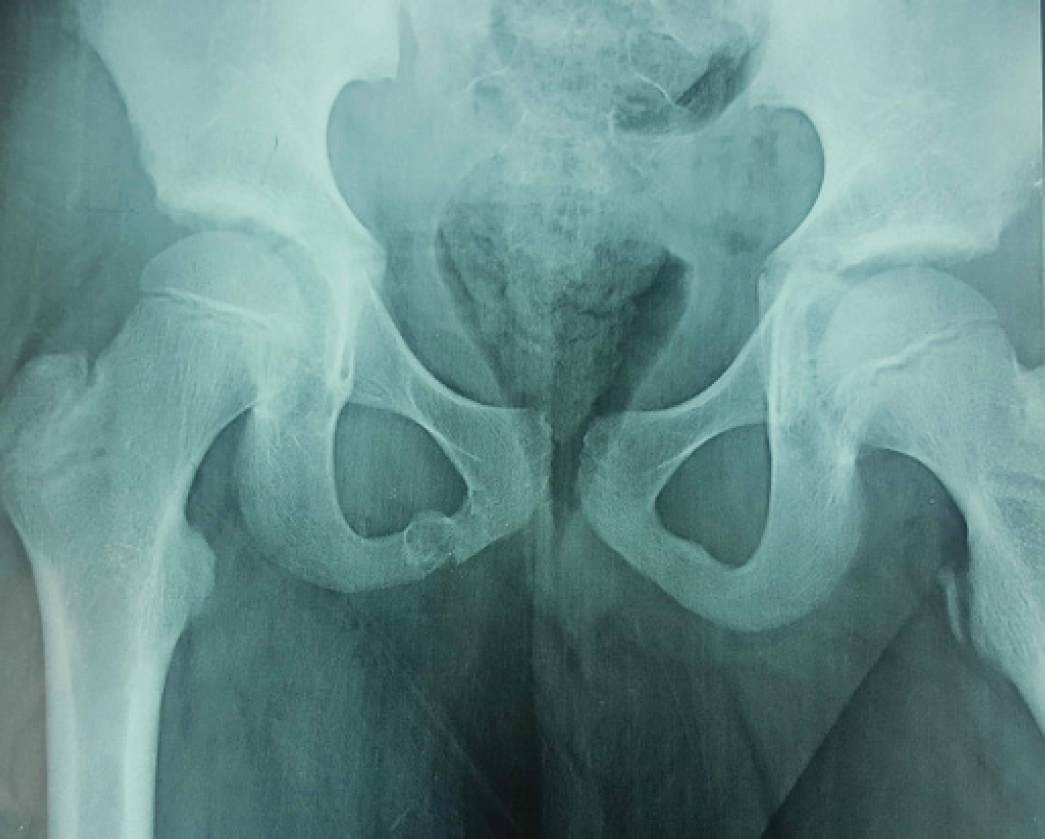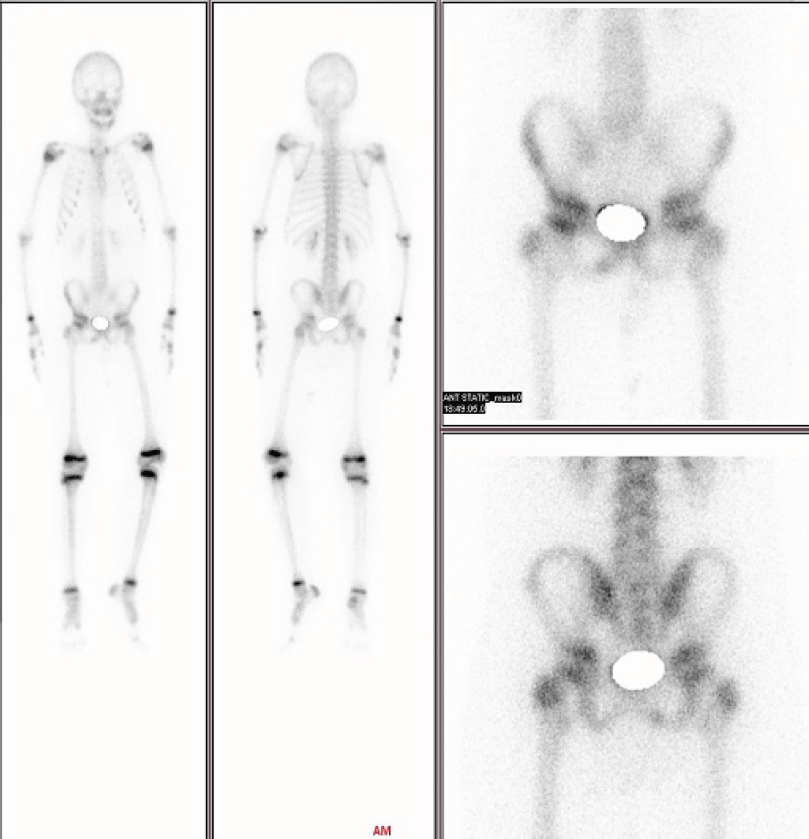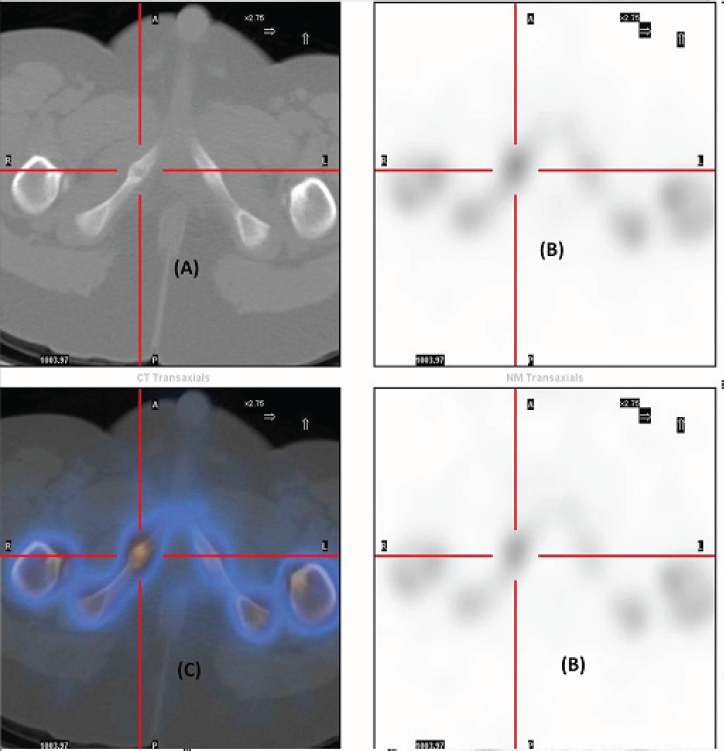Background
Ischio-pubic synchondrosis (IPS) is a sessile hyaline cartilage confluence between inferior ischial and pubic rami [1]. This transitory joint is seen in early infancy and annihilates with increase in age by either bony union or synostosis and is usually completely obliterated before puberty [2]. The enlargement of IPS is not an uncommon radiological finding, though in most of the cases it is considered as a normal growth phenomenon with no pathological impact. It is usually seen bilaterally in younger children due to bilateral symmetrical commencement of fusion in both hemi pelvises while unilateral enlargement is seen in older children before closure [3]. Usually, ossification of synchondrosis is clinically asymptomatic, though in some cases, children may complain of pain in the groin, hip or gluteal region. It may be associated with limitation of hip movement and limping gait referred as synchondrosis Ischio-pubic syndrome (SIS) [3,4]. Odelberg and van Neck described radiographic changes of SIS as bulge with demineralization of the ischio-pubic fusion region. They referred this unit as “osteochondritis ischio-pubica” also known as Van Neck-Odelberg disease [5,6]. Though these clinical features are highly non-specific and may be misleading especially in cases of equivocal radiographs. The differential diagnosis to be considered includes stress fracture, post traumatic osteolysis, osteomyelitis, and tumor [7,8].
99mTc-methylene diphosphonate (MDP) bone scan is widely used for evaluation of osteoblastic bone lesions [9]. We are reporting a case of Ischio-pubic osteochondritis as seen on 99mTc-MDP bone scan and hybrid imaging by Single photon emission computed tomography coupled with low dose computed tomography scan (SPECT/CT).
Case presentation
An 11 years old male patient visited nuclear medicine department of our hospital with a presenting complaint of pain in the right hip. There was no history of fever, trauma or fall. Clinically there were no clinical signs of inflammation or swelling. No signs of muscle spasm were noted. Both hip joints showed normal mobility in various plans. Recent X-ray showed lytic lesion in the right inferior ischio-pubic ramus with area of lucencies [Figure 1].
He was advised 99mTc-methylene diphosphonate (99mTc-MDP) bone scan, which was performed with Infinia dual head SPECT/CT gamma camera equipped with low energy high resolution collimators at 140KeV peak with 20% energy window. Bone scan showed focal area of increased uptake in the right inferior ischio-pubic ramus [Figure 2]. Complementary SPECT/CT was performed. Low dose 4 slices CT showed areas of demineralization at edges of ischio-pubic synchondrosis with areas of sclerosis, SPECT showing focal increased uptake in the inferior ischio-pubic ramus. Fused SPECT/CT images confirmed the focal uptake to be in the ischio-pubic synchondrosis [Figure 3]. Final diagnosis of Ischio-pubic Osteochondritis was made. Later patient was treated by orthopedic surgeon with anti-inflammatory drugs and steroids. Patient responded very well to treatment thus confirming our diagnosis.

X-ray showing lytic lesion in the right inferior ischio-pubic ramus with area of lucencies.

99mTc-MDP bone scan showing focal area of increased uptake in the right inferior ischio-pubic ramus.

99mTc-MDP bone scan with SPECT/CT images. (A) CT images showing areas of demineralization at edges of ischio-pubic synchondrosis and areas of sclerosis. (B) SPECT showing focal increased uptake in the inferior ischio-pubic ramus. (C) Fused SPECT/CT images confirms focal uptake to be in ischio-pubic synchondrosis.
Discussion
Ischio-pubic synchondrosis (IPS) is a transitory hyaline cartilage between inferior ischial and pubic rami [1]. This joint usually obliterates completely before puberty by bony union [2]. Its enlargement is not an uncommon radiological finding due to asymmetric closure of IPS, though it remains clinically asymptomatic. In some cases, children may present with pain in the groin, hip or gluteal region with restriction of hip movement and limping gait. This combination of clinical symptoms is usually referred as Synchondrosis Ischio-pubic syndrome (SIS) [3,4]. On plain X-rays, SIS is outlined as a bulge with areas of demineralization at IPS, referred by Odelberg and van Neck as “osteochondritis ischio-pubica” or “Van Neck-Odelberg disease” [5,6]. Multiple factors lead to enlargement of IPS, by inducing inflammatory response leading to delayed/deranged ossification. Most important of all, is uneven physical strain like kicking, dancing or jumping [4]. On conventional radiographs, its tumor like appearance can create panic. Therefore, it is very important to correctly and timely diagnose Ischio-pubic osteochondritis (IPO) as a benign disorder. Computed tomography (CT) scan usually show areas of sclerosis and lucencies. Diagnosis on magnetic resonance imaging (MRI) is usually on basis of abnormal marrow signals with fibrous bridging [4]. The differential diagnosis includes stress fracture, post traumatic osteolysis, osteomyelitis, and tumor [7,8]. Stress fractures of pubic rami in athletes can be challenging at times. Osteomyelitis is usually associated with a cascade of clinical symptom. Radiologically bony destruction with adjacent soft tissue collection is usually a hallmark of osteomyelitis. A 99mTc-MDP bone scan is widely used for evaluation of osteoblastic bone lesions [9]. Osteo-blastic bone lesions can be identified about 18 months earlier on bone scan than X-rays [10]. Bone scan is least sensitive for lytic lesions. Multiple benign focal pathologies of bone can lead to false positive findings of skeletal metastasis/tumors e.g. fibrous dysplasia, enchondroma, osteoid osteoma, brown tumors due to hyper-parathyroidism, and degenerative bone disease [11]. Planer 99mTc-MDP bone scan with additional SPECT/CT hybrid imaging can enhance the sensitivity and specificity of procedure to pick small lesions and effectively characterize the target lesion [12,13]. In our case SPECT/CT helped to localize the target lesion to be in IPS, with additional characterization of the lesion with CT images. Correlating clinical picture with 99mTc-MDP bone scan and SPECT/CT images, a diagnosis of Ischio-pubic Osteochondritis (Van Neck-Odelberg disease) was made. Latter after treatment by orthopedic surgeon with anti-inflammatory, steroids and analgesic drugs coupled with complete bed rest improved symptoms dramatically, confirming diagnosis of Ischio-pubic Osteochondritis.
Conclusion
Ischio-pubic Osteochondritis (Van Neck-Odelberg disease) is one of the differential diagnosis (DDs) in children presenting with pain in the groin, hip or gluteal region and limping gait. It is emphasized that ample awareness of this ailment is necessary for accurate and timely diagnosis in children. Early diagnosis and proper management can alleviate the suffering of child.

